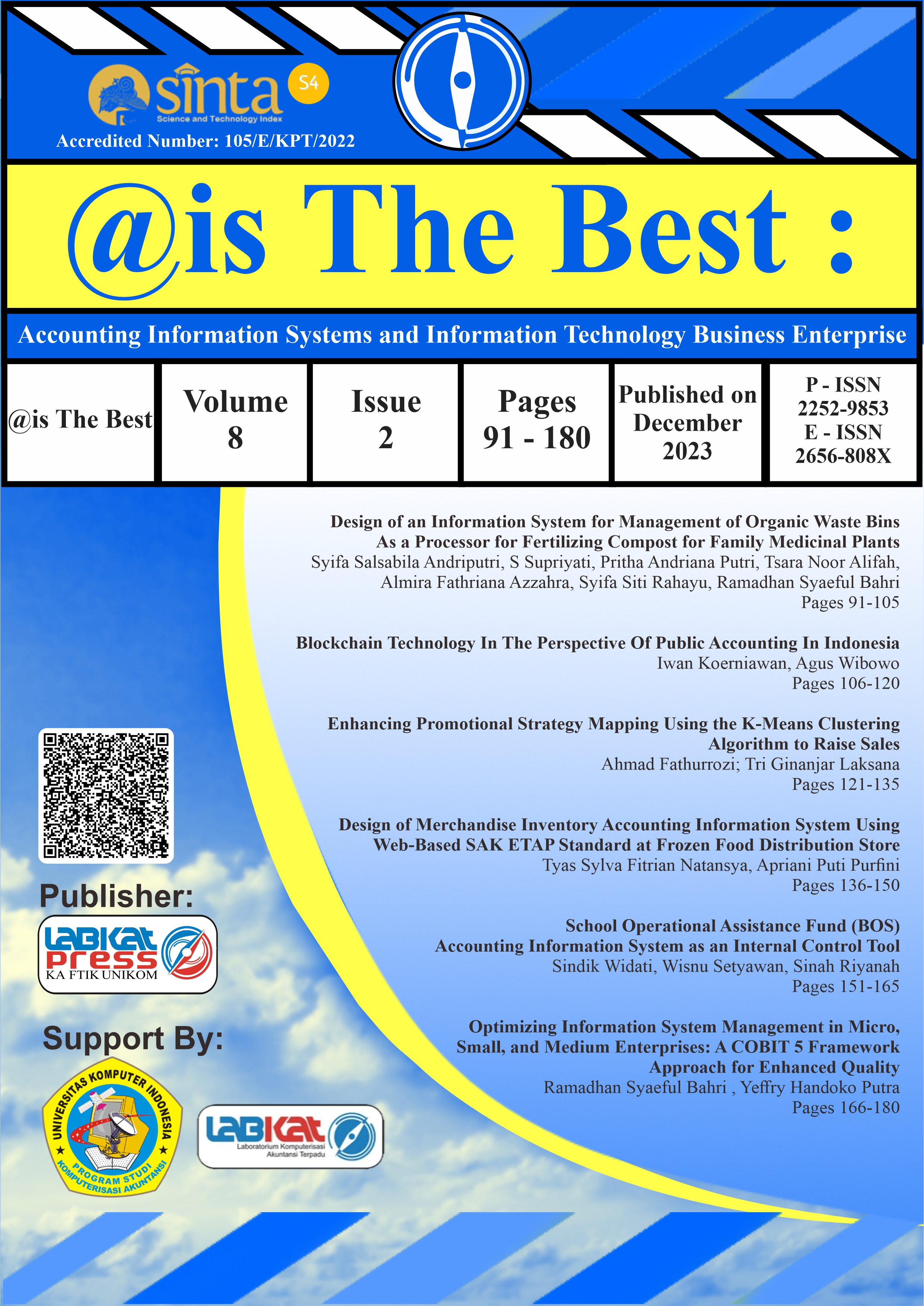Design of Merchandise Inventory Accounting Information System Using Web-Based SAK ETAP Standard at Frozen Food Distribution Store
Main Article Content
Abstract
Inventory of trade goods is important in the process of buying and selling activities in a trading company, in this case it can be concluded that inventory is important for every company to supervise and manage the inventory owned. This research was conducted at the Frozen Food Distribution Store located at Rajawali Timur Street No. 68, Ciroyom, Andir, Bandung City, West Java 40182. Frozen Food Distribution Store is a trading company, selling products in the form of Frozen Food types. The method to be used in the implementation of research is the descriptive method is the process of solving problems that will be researched by describing situations that are objects or subjects. There are three data collections, namely, observation, interview and literature review. The author made the design of this application based on the website, the purpose of making this information system is expected that this system will help in carrying out daily activities in trading at the Frozen Food Distribution Store. The use of this information system is to manage inventory well with inventory cards. The results of the author's research on frozen food distribution stores do not yet have a merchandise inventory information system in which financial statements are made, the information system is made to have inventory card features to financial reporting and receive income statements every month to see profits, according to applicable accounting standards. Merchandise inventory information systems can help with weaknesses in the running system.
Downloads
Article Details
Section

This Journal is licensed under a Creative Commons Attribution-ShareAlike 4.0 International License
How to Cite
References
N. N. Purnawan, T. H. Apandi, R. Piarna, S. Rahayu, M. Iqbal, dan Y. S. Nugroho, “Pengabdian Kepada Masyarakat : Sistem Informasi,” vol. 3, no. September, hal. 23–29, 2020.
N. Najla, S. Supriyati, dan D. A. Dewi, “Design of Sales Accounting Information System Using EMKM Accounting Standard,” @is The Best : Accounting Information Systems and Information Technology Business Enterprise, vol. 7, no. 2, hal. 166–180, 2023, doi: 10.34010/aisthebest.v7i2.9125.
S. Supriyati, S. Mulyani, H. Suharman, dan T. Supriadi, “The Influence of Business Models, Information Technology on the Quality of Accounting Information Systems Digitizing MSMEs Post-COVID-19,” Jurnal Sistem Informasi, vol. 18, no. 2, hal. 36–49, 2022, doi: 10.21609/jsi.v18i2.1141.
owusu et al, “Analisis Pengendalian Internal Persediaan Barang Dagang Pada Cv Pp Lumajang,” Prosiding Seminar Nasional & Call For Paper, no. 2019, hal. 161–167, 2019.
Supriyati, H. Suharman, dan T. Supriadi, “Business strategy and use of information technology toward ASEAN MSMEs performance in the post-pandemic crisis,” Journal of Eastern European and Central Asian Research (JEECAR), vol. 10, no. 5, hal. 886–897, Sep 2023, doi: 10.15549/jeecar.v10i5.1438.
T. Rahmasari, “Perancangan Sistem Informasi Akuntansi Persediaan Barang Dagang Pada Toserba Selamat Menggunakan Php Dan Mysql,” is The Best Accounting Information Systems and Information Technology Business Enterprise this is link for OJS us, vol. 4, no. 1, hal. 411–425, 2019, doi: 10.34010/aisthebest.v4i1.1830.
V. Sitinjak, “Analisis Pengendalian Persediaan Untuk Meminimalkan Biaya Persediaan Pada Perum Bulog Divisi Regional Riau Dan Kepri Di Gudang Pekanbaru,” SENKIM: Seminar Nasional Karya Ilmiah Multidisiplin, vol. 1, no. 1, hal. 284–298, 2021.
Yusi Maesaroh dan Elvia Puspa Dewi, “Analisis Akuntansi Persediaan Barang Dagang Berdasarkan PSAK 14 (Studi Kasus Pada PT XYZ-CTP 1),” Jurnal Buana Akuntansi, vol. 5, no. 1, hal. 1–14, 2020, doi: 10.36805/akuntansi.v5i1.1016.
M. A. Swasono dan A. T. Prastowo, “Analisis dan Perancangan Sistem Informasi Pengendalian Barang,” JATIKA (Jurnal Informatika dan Rekayasa Perangkat Lunak), vol. 2, no. 1, hal. 134–143, 2021.
T. Kuncara, F. R. Anggita, dan J. L. Utomo, “Analisis Penilaian Persediaan Barang Dagang Pada Rozan Mini Market & Percetakan Sesuai Sak Etap,” Owner, vol. 7, no. 2, hal. 965–973, 2023, doi: 10.33395/owner.v7i2.1286.
S. D. Paraswati et al., “Analisis Metode Pencatatan Dan Penilaian Persediaan Barang Dagang Pada Pt. Hasjrat Abadi Cabang Manado,” Jurnal EMBA: Jurnal Riset Ekonomi, Manajemen, Bisnis dan Akuntansi, vol. 9, no. 1, hal. 94–101, 2021.
A. Wicaksana dan T. Rachman, “Perencanaan Jumlah Tenaga Kerja Untuk Memenuhi Permintaan (Studi Kasus Pada UD. Setia Guna),” Angewandte Chemie International Edition, vol. 3, no. 1, hal. 10–27, 2018.
D. Prakasita N dan M. A. Nugroho, “Perancangan Sistem Informasi Akuntansi Penjualan Dan Persediaan Di Central Steak and Coffee Boyolali,” Nominal, Barometer Riset Akuntansi dan Manajemen, vol. 7, no. 1, hal. 69–81, 2018, doi: 10.21831/nominal.v7i1.19360.
S. Supriyati dan R. S. Bahri, “Model Perancangan Sistem Informasi Akuntansi Laporan Keuangan Pondok Pesantren Berbasis SAK ETAP,” is The Best Accounting Information Systems and Information Technology Business Enterprise this is link for OJS us, vol. 4, no. 2, hal. 151–165, 2020, doi: 10.34010/aisthebest.v4i02.2749.
A. Wahid Abdul, “Analisis Metode Waterfall Untuk Pengembangan Sistem Informasi,” Jurnal Ilmu-ilmu Informatika dan Manajemen STMIK, no. November, hal. 1–5, 2020.

